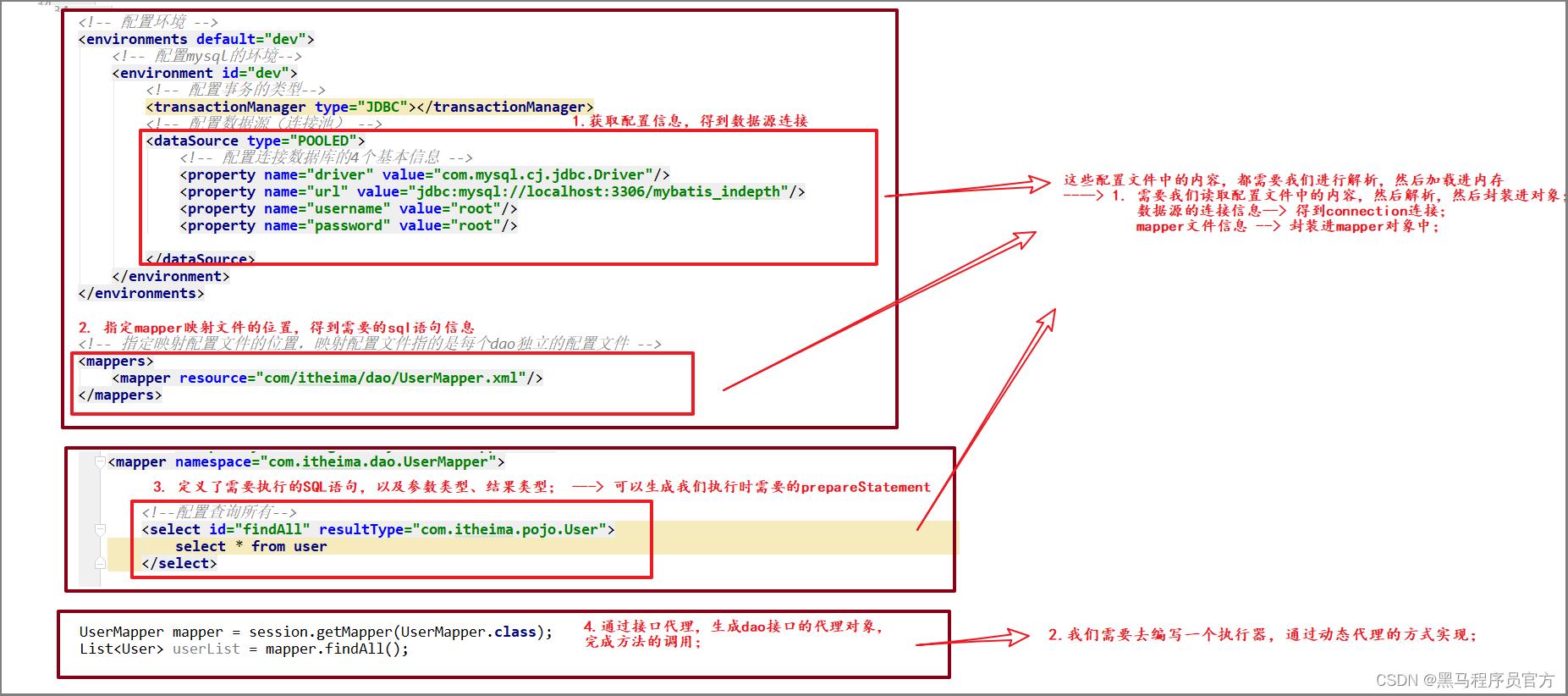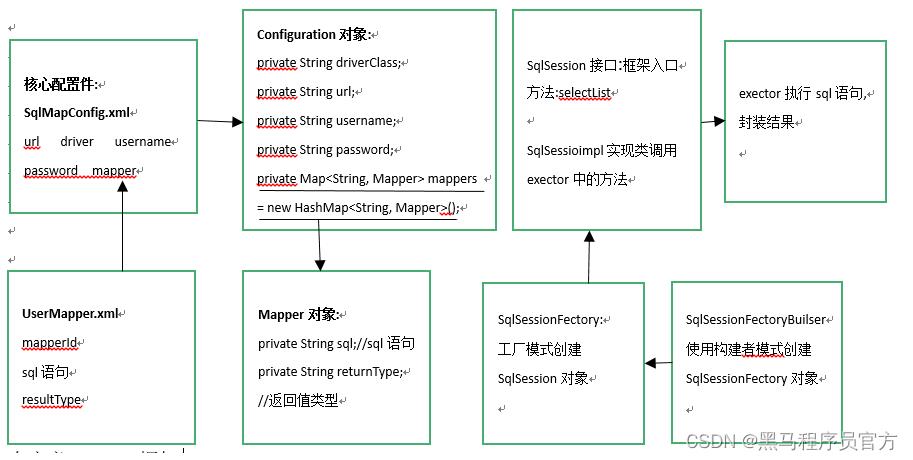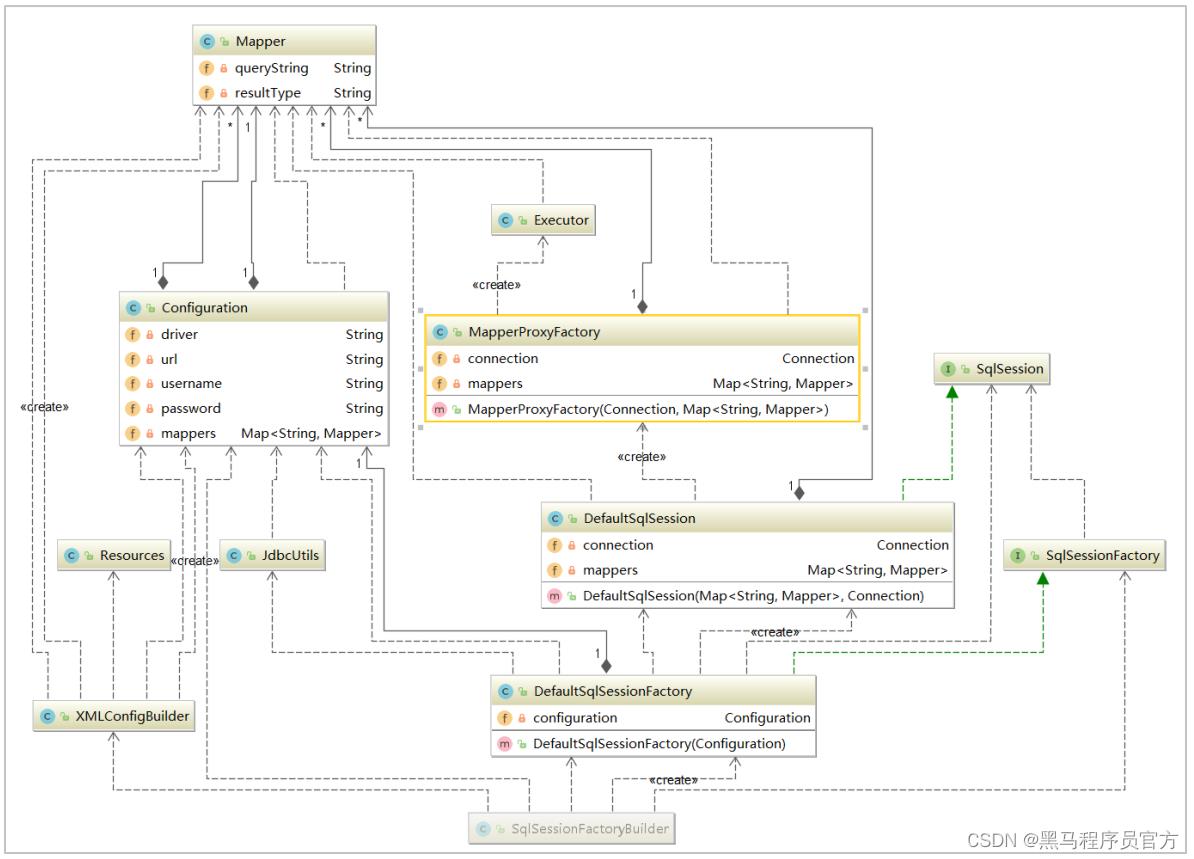MyBatis进阶之自定义MyBatis框架
Posted 黑马程序员官方
tags:
篇首语:本文由小常识网(cha138.com)小编为大家整理,主要介绍了MyBatis进阶之自定义MyBatis框架相关的知识,希望对你有一定的参考价值。
MyBatis进阶之自定义MyBatis框架
1. 自定义MyBatis框架流程分析

2. 自定义框架原理介绍


3. 准备工作:
1) 创建maven工程
Groupid:com.itheima
ArtifactId:custom-mybatis
Packing:jar
2) 添加pom依赖:
<dependency>
<groupId>mysql</groupId>
<artifactId>mysql-connector-java</artifactId>
<version>8.0.15</version>
</dependency>
<dependency>
<groupId>log4j</groupId>
<artifactId>log4j</artifactId>
<version>1.2.12</version>
</dependency>
<dependency>
<groupId>junit</groupId>
<artifactId>junit</artifactId>
<version>4.12</version>
</dependency>
<dependency>
<groupId>dom4j</groupId>
<artifactId>dom4j</artifactId>
<version>1.6.1</version>
</dependency>
<dependency>
<groupId>jaxen</groupId>
<artifactId>jaxen</artifactId>
<version>1.1.6</version>
</dependency>
<dependency>
<groupId>org.projectlombok</groupId>
<artifactId>lombok</artifactId>
<version>1.18.12</version>
</dependency>
4. 自定义MyBatis框架的实现步骤
需要定义的类的分析:
- 加载类加载目录下的资源文件
Resources.java - 映射文件解析后信息类
Mapper.java - 保存配置文件的配置信息
Configuration.java - 配置文件解析的工具类
XMLConfigBuilder.java - SQL语句的执行对象
Executor.java - 获取数据源的工具类
JdbcUtil.java SqlSession接口及实现类SqlSessionFactory接口及实现类SqlSessionFactory的构建者类SqlSessionFactoryBuilder.java- 动态代理的处理类
MapperProxyFactory.java
两大步:
1-4 : 是我们前面提到的 解析xml,封装对象;
5-10: 是得到sqlsession,获取代理对象,执行sql的核心代码;
包结构参考:
[外链图片转存失败,源站可能有防盗链机制,建议将图片保存下来直接上传(img-q35ax5hv-1666607263836)(assets/1597236187962.png)]
1)定义加载资源类Resources.java
/**
* 加载资源的工具类
*/
public class Resources
/**
* 加载类加载目录下的资源
* @param path
* @return
*/
public static InputStream getResourceAsStream(String path)
return Resources.class.getClassLoader().getResourceAsStream(path);
2)定义mybatis映射配置信息类 Mapper.java
/**
* 映射的配置信息类
*/
@Data
public class Mapper
private String queryString;// SQL语句
private String resultType;// 实体类全限定名
3)定义mybatis核心配置信息类 Configuration.java
/**
* mybatis配置的实体类
* 用来保存mybatis.xml解析过程中的节点属性
*/
@Data
public class Configuration
private String driver; //jdbc驱动类
private String url; //jdbc连接字符串
private String username; //数据库连接用户名
private String password; //数据库连接密码
private Map<String, Mapper> mappers = new HashMap<String, Mapper>();//映射文件
public void setMappers(Map<String, Mapper> mappers)
this.mappers.putAll(mappers);//此处需要使用追加的方式
4)配置文件解析的工具类XMLConfigBuilder
/**
* 用于解析配置文件:
* sqlmapconfig.xml
* xxxMapper.xml
*/
public class XMLConfigBuilder
//定义封装连接信息的配置对象(mybatis的配置对象)
private static Configuration cfg = new Configuration();
/**
* 解析主配置文件,把里面的内容填充到DefaultSqlSession所需要的地方
* 使用的技术:dom4j+xpath
*/
public static Configuration loadConfiguration(InputStream config)
try
//1.获取SAXReader对象
SAXReader reader = new SAXReader();
//2.根据字节输入流获取Document对象
Document document = reader.read(config);
//3.获取根节点
Element root = document.getRootElement();
//4. 解析数据源信息
loadDataSourceElement(root);
//5. 加载mapper
loadMapperElement(root);
//6. 返回Configuration
return cfg;
catch(Exception e)
throw new RuntimeException(e);
finally
try
config.close();
catch(Exception e)
e.printStackTrace();
/**
* 解析数据源信息
*/
public static void loadDataSourceElement(Element root)
//1.使用xpath中选择指定节点的方式,获取所有property节点
List<Element> propertyElements = root.selectNodes("//property");
//2.遍历节点
for(Element propertyElement : propertyElements)
//判断节点是连接数据库的哪部分信息
//取出name属性的值
String name = propertyElement.attributeValue("name");
if("driver".equals(name))
//表示驱动
//获取property标签value属性的值
String driver = propertyElement.attributeValue("value");
cfg.setDriver(driver);
if("url".equals(name))
//表示连接字符串
//获取property标签value属性的值
String url = propertyElement.attributeValue("value");
cfg.setUrl(url);
if("username".equals(name))
//表示用户名
//获取property标签value属性的值
String username = propertyElement.attributeValue("value");
cfg.setUsername(username);
if("password".equals(name))
//表示密码
//获取property标签value属性的值
String password = propertyElement.attributeValue("value");
cfg.setPassword(password);
/**
* 加载mapper
*/
public static void loadMapperElement(Element root) throws Exception
//取出mappers中的所有mapper标签,判断他们使用了resource还是class属性
List<Element> mapperElements = root.selectNodes("//mappers/mapper");
//遍历集合
for(Element mapperElement : mapperElements)
//判断mapperElement使用的是哪个属性
Attribute attribute = mapperElement.attribute("resource");
if(attribute != null)
System.out.println("------XML方式mapper----");
//表示有resource属性,用的是XML
//取出属性的值
String mapperPath = attribute.getValue();//获取属性的值"com/itheima/dao/IUserDao.xml"
//把映射配置文件的内容获取出来,封装成一个map
Map<String,Mapper> mappers = loadMapperConfiguration(mapperPath);
//给configuration中的mappers赋值
cfg.setMappers(mappers);
/**
* 根据传入的参数,解析XML,并且封装到Map中
* @param mapperPath 映射配置文件的位置
* @return map中包含了获取的唯一标识(key是由dao的全限定类名和方法名组成)
* 以及执行所需的必要信息(value是一个Mapper对象,里面存放的是执行的SQL语句和要封装的实体类全限定类名)
*/
private static Map<String,Mapper> loadMapperConfiguration(String mapperPath)throws IOException
InputStream in = null;
try
//定义返回值对象
Map<String,Mapper> mappers = new HashMap<String,Mapper>();
//1.根据路径获取字节输入流
in = Resources.getResourceAsStream(mapperPath);
//2.根据字节输入流获取Document对象
SAXReader reader = new SAXReader();
Document document = reader.read(in);
//3.获取根节点
Element root = document.getRootElement();
//4.获取根节点的namespace属性取值
String namespace = root.attributeValue("namespace");//是组成map中key的部分
//5.获取所有的select节点
List<Element> selectElements = root.selectNodes("//select");
//6.遍历select节点集合
for(Element selectElement : selectElements)
//取出id属性的值 组成map中key的部分
String id = selectElement.attributeValue("id");
//取出resultType属性的值 组成map中value的部分
String resultType = selectElement.attributeValue("resultType");
//取出文本内容 组成map中value的部分
String queryString = selectElement.getText();
//创建Key
String key = namespace+"."+id;
//创建Value
Mapper mapper = new Mapper();
mapper.setQueryString(queryString);
mapper.setResultType(resultType);
//把key和value存入mappers中
mappers.put(key,mapper);
return mappers;
catch(Exception e)
throw new RuntimeException(e);
finally
in.close();
5)SQL语句的执行对象Executor.java
/**
* 负责执行SQL语句,并且封装结果集
*/
public class Executor
/**
* 根据mapper查询多条数据
* @param mapper
* @param conn
* @param <E>
* @return
*/
public <E> List<E> selectList(Mapper mapper, Connection conn)
PreparedStatement pstm = null;
ResultSet rs = null;
try
//1.取出mapper中的数据
String queryString = mapper.getQueryString();//select * from user
String resultType = mapper.getResultType();//com.itheima.domain.User
Class domainClass = Class.forName(resultType);
//2.获取PreparedStatement对象
pstm = conn.prepareStatement(queryString);
//3.执行SQL语句,获取结果集
rs = pstm.executeQuery();
//4.封装结果集
List<E> list = new ArrayList<E>();//定义返回值
while (rs.next())
//将结果集中的数据封装到实体中
E obj = extraction(rs, domainClass);
//把赋好值的对象加入到集合中
list.add(obj);
return list;
catch (Exception e)
throw new RuntimeException(e);
finally
release(conn, pstm, rs);
/**
* 根据mapper查询数据,查询一条数据,如果结果集中有多条数据,返回第一条数据封装的实体对象
* @param mapper
* @param conn
* @param <E>
* @return
*/
public <E> E selectOne(Mapper mapper, Connection conn)
PreparedStatement pstm = null;
ResultSet rs = null;
try
//1.取出mapper中的数据
String queryString = mapper.getQueryString();//select * from user where id = ?
String resultType = mapper.getResultType();//com.itheima.domain.User
Class domainClass = Class.forName(resultType);
//2.获取PreparedStatement对象
pstm = conn.prepareStatement(queryString);
//3.执行SQL语句,获取结果集
rs = pstm.executeQuery();
//4.封装结果集
if (rs.next())
//将结果集中的数据封装到实体中
E obj = extraction(rs, domainClass);
return obj;
return null;
catch (Exception e)
throw new RuntimeException(e);
finally
release(conn, pstm, rs);
/**
* 将结果集中的一条数据封装到实体对象中
* @param rs
* @param domainClass
* @param <E>
* @return
* @throws Exception
*/
private <E> E extraction(ResultSet rs,Class domainClass) throws Exception
//实例化要封装的实体类对象
E obj = (E) domainClass.newInstance();
//取出结果集的元信息:ResultSetMetaData
ResultSetMetaData rsmd = rs.getMetaData();
//取出总列数
int columnCount = rsmd.getColumnCount();
//遍历总列数
for (int i = 1; i <= columnCount; i++)
//获取每列的名称,列名的序号是从1开始的
String columnName = rsmd.getColumnName(i);
//根据得到列名,获取每列的值
Object columnValue = rs.getObject(columnName);
//给obj赋值:使用Java内省机制(借助PropertyDescriptor实现属性的封装)
PropertyDescriptor pd = new PropertyDescriptor(columnName, domainClass);//要求:实体类的属性和数据库表的列名保持一种
//获取它的写入方法
Method writeMethod = pd.getWriteMethod();
//把获取的列的值,给对象赋值
writeMethod.invoke(obj, columnValue);
return obj;
private void release(Connection conn, PreparedStatement pstm, ResultSet rs)
if (rs != null)
try
rs.close();
catch (Exception e)
e.printStackTrace();
if (pstm != null)
try
pstm.close();
catch (Exception e)
e.printStackTrace();
if (conn != null)
try
conn.close();
catch (Exception e)
e.printStackTrace();
6)编写获取数据源的工具类JdbcUtil
/**
* 用于创建数据源的工具类
*/
public class JdbcUtil
/**
* 用于获取一个连接
* @param cfg
* @return
*/
public static Connection getConnection(Configuration cfg)
try
Class.forName(cfg.getDriver());
return DriverManager.getConnection(cfg.getUrl(), cfg.getUsername()以上是关于MyBatis进阶之自定义MyBatis框架的主要内容,如果未能解决你的问题,请参考以下文章